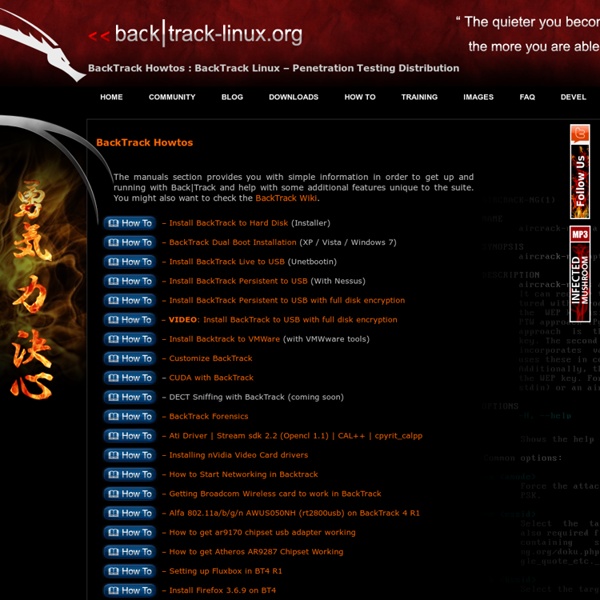



Project Frenzy - FreeBSD-based LiveCD SecurityTube Tools GnackTrack - Gnome Based Penetration Distro GnackTrackR6!!! GnackTrackR6 is now officially released. R6 has recieved support from some new DEVs so we now have more fingers working on GnackTrack. We have added patches to the compat-wireless modules so R6 has better support for injection and monitor mode. Click here to download the live CD GnackTrackR6.iso Click here to download the live CD GnackTrackR6.iso.torrent 3bc79e7bc733fd6d4a15b0fb075c3c64 GnackTrackR6.iso Click here to download the VMWare image GnackTrackR6.7z f70241fb268f11f061e6fa0361a746ea GnackTrackR6.7z GnackTrack WiFi Fix We have had recent issues with wireless within GnackTrack and have had to release a fix for better (and faster) packet injection. Ethan Dotson has been hard at work testing and creating this script in order to fix the wireless injection support within GnackTrack version R4 and R5. Click here to download the fix-wireless.sh script. Or if you're feeling lazy simply copy and paste the following code into a terminal. GnackTrackR5!!! GnackTrackR4!!! GnackTrackR3!!!
daily grml snapshots / builds About This page provides automatically generated snapshots of the Grml Linux Live system which were built using grml-live. If you don't know what Grml is, please see the Grml FAQ. WARNING: Feel free to use the ISOs but please note that they are not official stable releases. They contain the latest code, but bugs are also likely. In fact, these snapshots may not work at all. Please report any bugs you notice. Download Note: the first link on each line points to the most recent available snapshot of the corresponding Grml flavour. Debian testing based Grml images grml-full grml64-full_testing (64bit): latest ISO sha1 -- Older Versions grml32-full_testing (32bit): latest ISO sha1 -- Older Versions grml-small grml64-small_testing (64bit): latest ISO sha1 -- Older Versions grml32-small_testing (32bit): latest ISO sha1 -- Older Versions Debian unstable based Grml images grml64-full_sid (64bit): latest ISO sha1 -- Older Versions grml32-full_sid (32bit): latest ISO sha1 -- Older Versions base files
DEFT Linux - Computer Forensics live cd Justin Ribeiro / How to use Perl, Tor, and cURL to game an IP check voting engine Every once in a while I like to spend some time looking at a problem that isn’t even a problem. Maybe it’s a proof of concept, maybe it’s something that just vastly has the potential to be something more. Other times, maybe I just want to game the system just because I can. Gaming online voting has been around since the invention of online voting. The site in question (which shall remain nameless) had some 50 candidates (ideas one might call them) that could receive votes. Time to load up Tor. To test my IP address restriction theory, I ran Tor, submitted vote again, and it worked. I set this up on Linux. . Since we can now change our identity at will, lets work on the POST. curl -s --socks4a localhost:9050 -e {YOUR_REFERER} -d '{POST_VARS}' -A '{USER_AGENT}' {TARGET_SCRIPT} What exactly is that piece of command line gold doing? This simple command will submit a single vote to a target and return what ever the target script has to offer. I like Perl a lot.
Hacking Illustrated: Computer security videos Phreaknic 12 (2008) Hacker Con This is a quick and dirty video documentary of the things that when on around the talks and event at Phreaknic 12 (2008). Don't watch if you get sick at shaky cam movies like Blair Witch or Cloverfield. Intro and leaving Louisville with Brian. HackQuest :: Learn about Hacking, Cracking, JavaScript, PHP, Cryptology and Password security AntiSec and Anonymous: Is Law Enforcement Barking up the Wrong Tree? Following a series of high end hacks against US authorities, analysts have come to question whether law enforcement can ever really deal with the Anonymous collective. The debate re-emerged on 3 January after Anonymous posted a link to an MP3 recording of a conference call between the FBI and Scotland Yard. The call chronicled a conversation between the FBI and British authorities discussing the two's ongoing LulzSec and Anonymous investigations. The fact that the majority of the call was spent with each agency sharing the information it had - not all of which was uniform in what it was saying - demonstrated the problem facing law enforcement agencies hunting for Anonymous members. How Deep Does the Rabbit Warren Run? Operating off an open IRC channel, the collective allows any user to join and become a member, or "Anon" as they tend to refer to themselves. As noted by Sophos analysts Graham Cluley: "A problem with Anonymous's structure is that it has *no* structure and no real members.